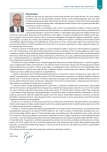Secondary dislipidemia in renal disease
Authors:
Jan Vachek; MUDr. PhDr. Oskar Zakiyanov, PhD.; Vladimír Tesař
Authors‘ workplace:
Klinika nefrologie 1. LF UK a VFN v Praze
Published in:
AtheroRev 2016; 1(2): 80-84
Category:
Reviews
Overview
In patients with chronic renal disease, complex disorder of lipid metabolism (so called uremic hyperlipoproteinemia) is present, being characterized by increased level of triglycerides and changes in total cholesterol levels. Due to favorable results of interventional statin studies in general population regarding cardiovascular morbidity and mortality, a similar effect in populations with kidney disease was expected. However, such effect was not confirmed in free large studies, perhaps since dominating risk factors cannot be influenced by statin treatment. A brief summary based on the current Kidney Disease: Improving Global Outcomes (KDIGO) recommendations regarding dyslipidemia treatment in patients with impaired renal fiction is presented. It can be concluded that in patients with eGFR decreased below 60 ml / min should be treated with statins, or a combination of statin / ezetimibe, whereas in dialysis patients therapy should not be newly initiated but should be continued in patients treated before.
Key words:
dyslipidemia – chronic kidney disease (CKD) – statins – fibrates – ezetimibe
Sources
1. Moorhead J, Chan MK, El-Nahas M et al. Lipid nephrotoxicity in chronic progressive glomerular and tubulo-interstitial disease. Lancet 1982; 2(8311): 1309–1311.
2. Liu Y, Coresh J, Eustace JA et al. Association between cholesterol level and mortality in dialysis patients: role of inflammation and malnutrition. JAMA 2004; 291(4): 451–459.
3. Contreras G, Hu B, Astor BC et al. Malnutrition-inflammation modifies the relationship of cholesterol with cardiovascular disease. J Am Soc Nephrol 2010; 21(12): 2131–2142.
4. Baigent C, Landray MJ, Reith C et al. [SHARP Investigators]. The effects of lowering LDL cholesterol with simvastatin plus ezetimibe in patients with chronic kidney disease (Study of Heart and Renal Protection): a randomised placebo-controlled trial. Lancet 2011; 377(9784): 2181–2192.
5. März W, Genser B, Drechsler C et al. German Diabetes and Dialysis Study Investigators. Atorvastatin and low-- density lipoprotein cholesterol in type 2 diabetes mellitus patients on hemodialysis. Clin J Am Soc Nephrol 2011; 6(6): 1316–1325.
6. 6.Fellström BC, Jardine AG, Schmieder RE et al. [AURORA Study Group]. Rosuvastatin and cardiovascular events in patients undergoing hemodialysis. N Engl J Med 2009; 360(14): 1395–1407.
7. Briasoulis A, Bakris GL. Chronic kidney disease as a coronary artery disease risk equivalent. Curr Cardiol Rep 2013; 15(3): 340. Dostupné z DOI: <http://dx.doi.org/10.1007/s11886–012–0340–4>.
8. Cheung AK, Parker CJ, Ren K et al. Increased lipase inhibition in uremia: identification of pre-beta-HDL as a major inhibitor in normal and uremic plasma. Kidney Int 1996; 49(5): 1360–1371.
9. Speer T, Rohrer L, Blyszczuk P et al. Abnormal high-density lipoprotein induces endothelial dysfunction via activation of toll-like receptor-2. Immunity 2013; 38(4): 754–768.
10. Lacour B, Roullet JB, Liagre AM et al. Serum lipoprotein disturbances in primary and secondary hyperparathyroidism and effects of parathyroidectomy. Am J Kidney Dis 1986; 8(6): 422–429.
11. Akmal M, Perkins S, Kasim SE et al. Verapamil prevents chronic renal failure-induced abnormalities in lipid metabolism. Am J Kidney Dis 1993; 22(1): 158–163.
12. Gaston RS, Kasiske BL, Fieberg AM et al. Use of cardioprotective medications in kidney transplant recipients. Am J Transplant 2009; 9(8): 1811–1815.
13. Gonyea JE, Anderson CF. Weight change and serum lipoproteins in recipients of renal allografts. Mayo Clin Proc 1992; 67(7): 653–657.
14. Moore R, Thomas D, Morgan E et al. Abnormal lipid and lipoprotein profiles following renal transplantation. Transplant Proc 1993; 25(1 Pt 2): 1060–1061.
15. Stone NJ, Robinson J, Lichtenstein AH et al. 2013 ACC/AHA guideline on the treatment of blood cholesterol to reduce atherosclerotic cardiovascular risk in adults: a report of the American College of Cardiology/American Heart Association Task Force on Practice Guidelines. J Am Coll Cardiol 2014; 63(25 Pt B): 2889–2934. Dostupné z DOI: <http://dx.doi.org/10.1016/j.jacc.2013.11.002>. Erratum in J Am Coll Cardiol 2015; 66(24): 2812. J Am Coll Cardiol 2014; 63(25 Pt B): 3024–3025.
16. Mihaylova B, Emberson J, Blackwell L et al. [Cholesterol Treatment Trialists' (CTT) Collaborators]. The effects of lowering LDL cholesterol with statin therapy in people at low risk of vascular disease: metaanalysis of individual data from 27 randomised trials. Lancet 2012; 380(9841): 581–590.
17. Miller M, Stone NJ, Ballantyne C et al. Triglycerides and cardiovascular disease: a scientific statement from the American Heart Association. Circulation 2011; 123(20): 2292–2333.
18. Wanner Ch, Tonelli M. [Kidney Disease: Improving Global Outcomes Lipid Guideline Development Work Group Members]. KDIGO Clinical Practice Guideline for Lipid Management in CKD: summary of recommendation statements and clinical approach to the patient. Kidney Int 2014; 85(6): 1303–1309.
19. Inker LA, Astor BC, Fox CH et al. KDOQI US Commentary on the 2012 KDIGO Clinical Practice Guideline for the evaluation and management of CKD. Am J Kidney Dis 2014; 63(5): 713–735.
20. Bayer ND, Cochetti PT, Kumar MS et al. Association of metabolic syndrome with development of new-onset diabetes after transplantation. Transplantation 2010; 90(8): 861–866.
21. Gonyea JE, Anderson CF. Weight change and serum lipoproteins in recipients of renal allografts. Mayo Clin Proc 1992; 67(7): 653–657.
22. Holdaas H, Fellstrom B, Cole E et al. Long-term cardiac outcomes in renal transplant recipients receiving fluvastatin: the ALERT extension study. Am J Transplant 2005; 5(12): 2929–2936. Erratum in Am J Transplant 2006; 6(8): 1986.
Labels
Angiology Diabetology Internal medicine Cardiology General practitioner for adultsArticle was published in
Athero Review

2016 Issue 2
- Memantine in Dementia Therapy – Current Findings and Possible Future Applications
- Metamizole vs. Tramadol in Postoperative Analgesia
- Metamizole at a Glance and in Practice – Effective Non-Opioid Analgesic for All Ages
- Memantine Eases Daily Life for Patients and Caregivers
- Advances in the Treatment of Myasthenia Gravis on the Horizon
Most read in this issue
- Monoclonal antibodies in the internal medicine
- Diabetes mellitus and lipid metabolism
- Alirocumab, Praluent® in the light of studies
- LDL-cholesterol – the main risk factor for atherosclerosis
